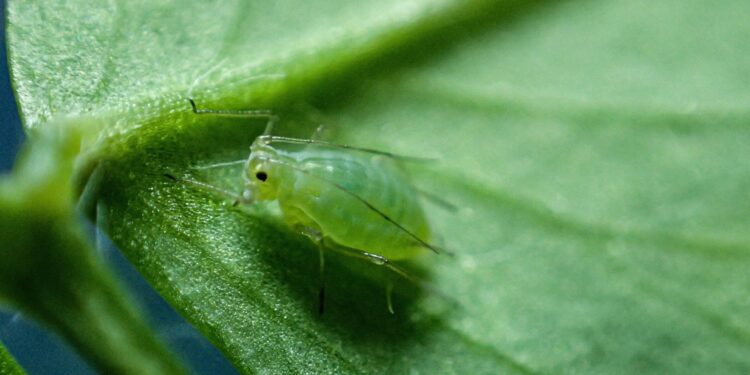Blue-green aphid on leaf. Credit: Cesar Australia
For the first time, Australian researchers have documented insecticide resistance in field-collected populations of the blue-green aphid, Acyrthosiphon kondoi, a global pest of pulses and other legumes.
The study, published in Pest Control Scienceserves as a warning to growers around the world and highlights the need for new strategies to combat this ubiquitous pest.
Evatt Chirgwin, an evolutionary biologist at Cesar Australia and corresponding author of the study, explained that the research was motivated by reports of conventional insecticides failing to control populations of A. kondoi.
“Our main motivation was to help Australian growers understand a new pest management challenge,” Chirgwin said. “Australian growers have traditionally used two types of insecticides (organophosphates and carbamates) to protect their legume crops against A. kondoi. However, in recent years several growers in southern Australia have reported that these sprays of insecticides no longer controlled A. kondoi, which indicated that this pest may have developed resistance to insecticides for the first time.
A. kondoi is an agricultural pest in the United States, South America, Asia, Europe, Africa and Australia. Chirgwin explained that they damage crops by feeding on the upper leaves, stems and terminal buds. “A. kondoi also causes indirect damage by spreading plant viruses, including cucumber mosaic virus and bean yellow mosaic virus,” he noted.
Blue-green aphids on petri dishes containing alfalfa leaves in 1% (w/v) agar. Credit: Cesar Australia
The team collected populations of A. kondoi in lentil and alfalfa paddocks where insecticide control failures have recently been reported in Victoria, South Australia and New South Wales. Populations were exposed to different insecticides in bioassays, revealing moderate resistance to three groups of insecticides: organophosphates, carbamates and pyrethroids.
Explaining the impact of resistance at this level on Australian growers, Chirgwin said: “From a practical standpoint, growers cannot rely on organophosphates and carbamates (at the recorded rate) to confidently control these populations of A. newly evolved kondoi. the moderate to moderate (20- to 40-fold) levels of resistance demonstrated by A. kondoi in this study are lower than those of some other aphid species (i.e., >100-fold) that may have evolved toward these chemicals .
Chirgwin noted that the discovery of populations of A. kondoi resistant to pyrethroids was unexpected: the use of pyrethroids to control A. kondoi in Australia is relatively limited and therefore the authors did not believe that the insects would be under sufficient selection pressure to develop resistance.
“We now suspect that A. kondoi populations are regularly exposed to pyrethroid-based insecticides, as this chemical is widely used in legume and pasture seed crops to control other pests (e.g. mirids, Helicoverpa and other aphids) which are often present alongside A. kondoi.,” he explained.
Researchers found no evidence of resistance to another insecticide, flupyradifurone. This is not surprising given that the chemical was only introduced to the Australian market in 2016 and is not registered against A. kondoi in the country.
Blue-green aphids on leaf. Credit: Cesar Australia
The authors conclude that flupyradifurone may therefore provide a new chemical option for controlling A. kondoi in Australia. Chirgwin cautioned and stressed the importance of integrated pest management strategies to limit the emergence of new cases of insecticide resistance:
“If registered, flupyradifurone is expected to provide only part of the management strategy for A. kondoi in Australia. Over-reliance on one (or a small number) of insecticides will place populations of A. kondoi under constant and strong selection pressure that favors the evolution of increased resistance.”
“Rotation between different types of insecticides can help alleviate selection pressure on pest populations. As such, growers need multiple chemical options to control A. kondoi and for these chemicals to be available at an economical price.”
“Greater support for non-chemical control options may also provide alternative pathways to manage A. kondoi and reduce selection for insecticide resistance. Natural enemies (e.g., ladybugs and parasitoid wasps) provide one control option biological effective for many aphids. Alternatively, growers can use certain crops (e.g. medicinal plants) where cultivars have been bred with a plant resistant to aphid feeding.
“Increasingly new endosymbionts (a type of bacteria harbored by many animals) have revolutionized the way certain mosquito disease vectors are managed, and similar endosymbiont-based interventions are currently being investigated as a new avenue to combat against agricultural pests.
“We are trying to map where populations of insecticide-resistant A. kondoi have spread so we can provide growers with more region-specific management recommendations. We are also exploring natural biological control options available for this pest and how endosymbionts may offer a new avenue to mitigate the damage caused by this pest to crops,” Chirgwin noted.
More information:
Evatt Chirgwin et al, Discovery of insecticide resistance in field-collected populations of the harmful aphid, Acyrthosiphon kondoi Shinji, Pest Control Science (2023). DOI: 10.1002/ps.7864
Provided by the Chemical Industry Society
Quote: Researchers warn of global threat to crops as insecticide resistance emerges in blue-green aphids (January 17, 2024) retrieved January 18, 2024 from
This document is subject to copyright. Except for fair use for private study or research purposes, no part may be reproduced without written permission. The content is provided for information only.



